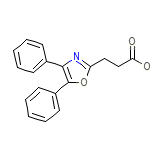Voir




Categoria
Voir Nombres de marca, Voir Analogos
Voir Marca los nombres de mezcla
Voir Formula quimica
Voir RX enlace
Voir FDA hoja
Voir MSDS (hoja de seguridad de materiales)
Voir Sintesis de referencia
Voir Peso molecular
Voir Punto de fusion
Voir H2O Solubilidad
Voir Estado
Voir LogP
Voir Formas de dosificacion
Voir Indicacion
Voir Farmacologia
Voir Absorcion
Voir Toxicidad
Voir Informacion de Pacientes
Daypro, like other drugs of its class, can cause discomfort and, rarely, more serious side effects, such as gastrointestinal bleeding, which may result in hospitalization and even fatal outcomes. Although serious gastrointestinal tract ulcerations and bleeding can occur without warning symptoms, patients should be alert for the signs and symptoms of ulcerations and bleeding, and should ask for medical advice when observing any indicative sign or symptoms. Patients should be apprised of the importance of this follow-up.
Patients should report to their physicians the signs or symptoms of gastrointestinal ulceration or bleeding, skin rash, weight gain, or edema.
Patients should be informed of the warning signs and symptoms of hepatotoxicity (e.g., nausea, fatigue, lethargy, pruritus, jaundice, right upper quadrant tenderness, and “flu-like” symptoms). If these occur, patients should be instructed to stop therapy and seek immediate medical therapy.
Patients should also be instructed to seek immediate emergency help in the case of an anaphylactoid reaction.
In late pregnancy, as with other NSAIDs, Daypro should be avoided because it will cause premature closure of the ductus arteriosus.














